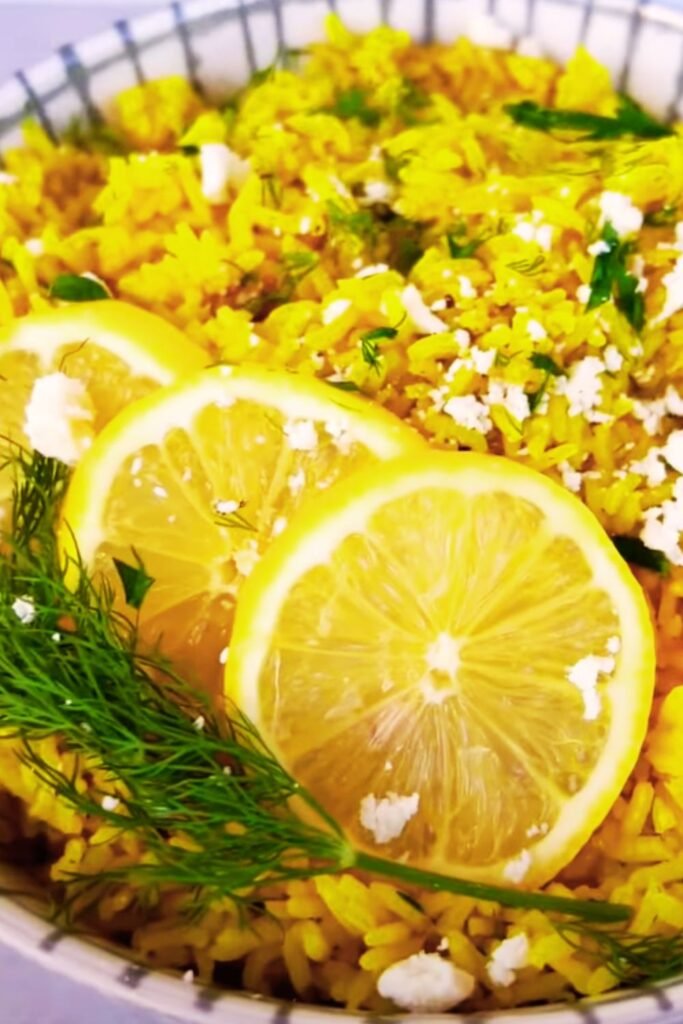When I first tasted authentic Greek rice in a small taverna overlooking the Aegean Sea, I knew I had discovered something magical. The combination of bright lemon, fragrant herbs, and perfectly cooked rice created a symphony of Mediterranean flavors that transported me straight to the sun-drenched islands of Greece. Today, I’m excited to share this beloved recipe that has become a cornerstone of my Mediterranean cooking repertoire.
Greek rice, or “rizi” as it’s known locally, represents the heart of Greek comfort food. Unlike plain steamed rice, this dish transforms humble grains into a aromatic masterpiece that perfectly balances tangy citrus notes with earthy herbs and rich olive oil. Whether you’re serving it alongside grilled fish, roasted lamb, or enjoying it as a standalone vegetarian meal, this flavor-packed rice will elevate any dining experience.
Understanding Greek Rice: More Than Just a Side Dish
Greek rice differs significantly from other Mediterranean rice preparations. While Spanish paella focuses on saffron and seafood, and Italian risotto emphasizes creamy textures, Greek rice celebrates the pure, clean flavors of lemon, olive oil, and fresh herbs. The technique involves creating a sofrito base—a aromatic foundation of sautéed onions and garlic—before adding the rice and liquid.
Key Characteristics of Authentic Greek Rice:
- Light, fluffy texture with separate grains
- Bright, lemony flavor profile
- Generous use of extra virgin olive oil
- Fresh herb integration
- Perfect balance of acidity and richness
The secret lies in the cooking method. Rather than simply boiling rice in water, Greek cooks create layers of flavor by building an aromatic base, toasting the rice briefly, then adding warm broth infused with lemon juice and herbs. This technique ensures every grain absorbs maximum flavor while maintaining the perfect texture.
Essential Ingredients for Perfect Greek Rice
Creating authentic Greek rice requires specific ingredients that work together harmoniously. I’ve learned through years of experimentation that quality matters tremendously—using premium olive oil and fresh herbs makes an incredible difference in the final result.
Primary Ingredients
| Ingredient | Quantity | Purpose | Quality Notes |
|---|---|---|---|
| Long-grain rice | 1½ cups | Base grain | Basmati or jasmine work best |
| Extra virgin olive oil | ⅓ cup | Flavor foundation | Use high-quality Greek or Italian |
| Yellow onion | 1 medium | Aromatic base | Sweet onions preferred |
| Garlic cloves | 4-5 cloves | Depth of flavor | Fresh only, never powdered |
| Chicken or vegetable broth | 3 cups | Cooking liquid | Low-sodium preferred |
| Fresh lemon juice | ¼ cup | Brightness | From 2-3 lemons |
| Lemon zest | 2 tablespoons | Citrus oils | Organic lemons recommended |
Herb and Seasoning Profile
| Herb/Seasoning | Amount | Role | Substitution Options |
|---|---|---|---|
| Fresh dill | 3 tablespoons | Primary herb | Dried dill (1 tablespoon) |
| Fresh parsley | 2 tablespoons | Color and freshness | Italian parsley preferred |
| Fresh oregano | 1 tablespoon | Mediterranean essence | Dried oregano (1 teaspoon) |
| Sea salt | 1 teaspoon | Flavor enhancement | Kosher salt works |
| Black pepper | ½ teaspoon | Subtle heat | Freshly ground only |
| Bay leaves | 2 leaves | Aromatic depth | Remove before serving |
The herb combination creates the signature Greek flavor profile. Dill provides the dominant herbal note, while parsley adds brightness and oregano contributes that unmistakable Mediterranean character. I always use fresh herbs when possible—the difference in flavor intensity is remarkable.

Step-by-Step Cooking Process
My technique for Greek rice has evolved over years of practice, incorporating traditional methods I learned from Greek home cooks. The key is patience and attention to detail—rushing any step compromises the final result.
Preparation Phase (10 minutes)
Ingredient Preparation:
- Rinse the rice in cold water until the water runs clear—this removes excess starch
- Finely dice the onion into uniform pieces for even cooking
- Mince garlic cloves, avoiding the green germ for mellower flavor
- Chop all fresh herbs and keep them separate
- Zest lemons before juicing to capture maximum citrus oils
- Warm the broth in a separate saucepan—cold broth stops the cooking process
Building the Sofrito Base (8-10 minutes)
The sofrito forms the flavor foundation of Greek rice. I heat the olive oil in a heavy-bottomed saucepan over medium heat—never high heat, which burns the oil and creates bitterness. The oil should shimmer but never smoke.
Adding the diced onion, I cook slowly until translucent and softened, approximately 5-6 minutes. The goal is gentle caramelization, not browning. Next comes the minced garlic, cooked for just 1-2 minutes until fragrant. Overcooking garlic creates harsh, bitter notes that overpower the delicate rice.
Rice Toasting Technique (3-4 minutes)
This step separates good Greek rice from exceptional Greek rice. I add the rinsed rice directly to the sofrito, stirring constantly to coat each grain with the aromatic oil mixture. The rice should toast lightly, becoming slightly opaque and releasing a nutty aroma. This toasting process helps the grains maintain their structure during cooking and adds complexity to the flavor profile.
Liquid Addition and Seasoning (2 minutes)
Carefully pour the warm broth into the pan—it will sizzle and steam dramatically. Add the bay leaves, salt, and pepper at this stage. The liquid level should cover the rice by approximately one inch. I bring the mixture to a gentle boil, then immediately reduce heat to low and cover the pan.
The Simmering Process (18-20 minutes)
Patience defines this crucial phase. The rice simmers covered on low heat without stirring—lifting the lid releases steam and disrupts the cooking process. After 18 minutes, I check by gently tilting the pan to see if liquid remains. If the rice appears dry and tender, it’s ready. If liquid remains, I continue cooking for 2-3 more minutes.
Final Flavor Integration (5 minutes)
Remove the pan from heat and let it rest covered for 5 minutes—this allows the rice to finish steaming and the flavors to meld. Remove the bay leaves, then add fresh lemon juice, lemon zest, and chopped herbs. I fold these ingredients gently with a fork to avoid mashing the rice grains.

Nutritional Benefits and Health Considerations
Greek rice offers impressive nutritional value beyond its incredible taste. The combination of whole grains, healthy fats, and fresh herbs creates a well-balanced dish that supports overall health and wellness.
Nutritional Breakdown (Per Serving)
| Nutrient | Amount | % Daily Value | Health Benefits |
|---|---|---|---|
| Calories | 285 | 14% | Sustained energy |
| Carbohydrates | 42g | 14% | Primary fuel source |
| Protein | 6g | 12% | Muscle maintenance |
| Fiber | 2g | 8% | Digestive health |
| Healthy fats | 12g | 18% | Heart health |
| Vitamin C | 15mg | 17% | Immune support |
| Folate | 45mcg | 11% | Cell function |
| Iron | 2mg | 11% | Oxygen transport |
Health-Promoting Compounds
The extra virgin olive oil provides monounsaturated fats that support cardiovascular health and reduce inflammation. Fresh herbs contribute antioxidants, particularly dill and parsley, which contain flavonoids and vitamin K. Lemon juice adds vitamin C and citric acid, which enhances iron absorption from the rice.
For individuals managing blood sugar, this dish offers moderate glycemic impact due to the fiber content and healthy fats that slow carbohydrate absorption. The portion size naturally controls caloric intake while providing satisfying flavors that reduce the desire for additional food.
Serving Suggestions and Pairing Ideas
Greek rice shines as both a supporting player and a starring attraction. My favorite serving approaches highlight its versatility while respecting its Mediterranean roots.
Traditional Greek Pairings
Main Dish Companions:
- Grilled lamb souvlaki with tzatziki sauce
- Pan-seared sea bass with olive tapenade
- Roasted chicken with Greek mountain oregano
- Stuffed grape leaves (dolmades) as an appetizer
- Greek-style baked cod with tomatoes and olives
Vegetarian Combinations:
- Spanakopita (spinach pie) with a simple Greek salad
- Roasted eggplant with feta and herbs
- Grilled halloumi cheese with fresh vegetables
- Mediterranean stuffed bell peppers
- Greek-style green beans in tomato sauce
Modern Fusion Applications
I’ve discovered that Greek rice adapts beautifully to contemporary dining styles. It works wonderfully in grain bowls topped with roasted vegetables, crumbled feta, and a drizzle of tahini. For entertaining, I serve it warm as part of a Mediterranean mezze spread alongside hummus, olives, and fresh bread.
The rice also excels as a base for protein bowls—topped with grilled chicken, roasted vegetables, and a dollop of Greek yogurt, it creates a complete, nutritious meal that satisfies without feeling heavy.

Storage, Reheating, and Meal Prep
Proper storage techniques ensure your Greek rice maintains its flavor and texture for several days. I’ve developed foolproof methods for keeping this dish fresh and delicious.
Short-Term Storage (3-4 days)
Refrigerate leftover Greek rice in airtight containers within two hours of cooking. The rice stays fresh for 3-4 days when stored properly. Before refrigerating, I let it cool completely to prevent condensation, which creates mushy texture.
Reheating Methods
| Method | Time | Results | Best For |
|---|---|---|---|
| Stovetop | 5-7 minutes | Best texture | Large portions |
| Microwave | 2-3 minutes | Quick and convenient | Single servings |
| Oven | 15-20 minutes | Even heating | Family portions |
| Steam basket | 8-10 minutes | Maintains moisture | Premium results |
For stovetop reheating, I add a tablespoon of broth or water, cover, and heat gently while stirring occasionally. This prevents drying and maintains the original texture. Microwave reheating works well with a damp paper towel covering the container to create steam.
Meal Prep Strategies
Greek rice makes excellent meal prep because the flavors actually improve after a day in the refrigerator. I often prepare a large batch on Sunday, then portion it into individual containers with different protein and vegetable combinations for varied weekday meals.
Weekly Meal Prep Ideas:
- Monday: Greek rice bowl with grilled chicken and cucumber salad
- Tuesday: Leftover rice with scrambled eggs and feta for breakfast
- Wednesday: Cold rice salad with cherry tomatoes and olives
- Thursday: Reheated rice with roasted vegetables and hummus
- Friday: Rice-stuffed bell peppers with ground turkey
Troubleshooting Common Issues
Through years of making Greek rice, I’ve encountered and solved virtually every problem that can arise. Here are the most common challenges and my proven solutions.
Texture Problems
Mushy Rice Solutions:
- Use less liquid (reduce broth by ¼ cup)
- Avoid over-stirring during cooking
- Let rice rest longer before serving
- Choose long-grain varieties over short-grain
Dry or Hard Rice Fixes:
- Add more warm broth gradually
- Extend cooking time by 5-10 minutes
- Check that heat isn’t too high
- Ensure rice was properly rinsed before cooking
Flavor Imbalances
Too Lemony:
- Add extra broth to dilute acidity
- Include a pinch of sugar to balance tartness
- Serve with creamy accompaniments like yogurt
Bland Results:
- Increase salt gradually while tasting
- Add more fresh herbs after cooking
- Include additional lemon zest for brightness
- Use higher-quality olive oil
Overly Oily Texture:
- Reduce olive oil in future preparations
- Rinse cooked rice gently with warm water
- Add fresh herbs to absorb excess oil
Recipe Variations and Adaptations
Greek rice adapts beautifully to different dietary needs and flavor preferences. I’ve developed several variations that maintain the dish’s essential character while accommodating various requirements.
Protein-Enhanced Versions
Greek Rice Pilaf with Chicken: Add diced cooked chicken during the final resting period for a complete one-pot meal. The residual heat warms the chicken without overcooking it.
Seafood Greek Rice: Incorporate cooked shrimp or flaked fish during the last few minutes of cooking. The delicate proteins complement the lemony herbs perfectly.
Vegetarian Protein Boost: Stir in cooked white beans or chickpeas for additional protein and fiber. These legumes absorb the rice flavors while adding satisfying substance.
Dietary Adaptations
| Dietary Need | Modifications | Notes |
|---|---|---|
| Gluten-free | No changes needed | Naturally gluten-free |
| Vegan | Use vegetable broth | Maintains full flavor |
| Low-sodium | Reduce salt, use herbs | Lemon brightens flavors |
| Keto-friendly | Replace rice with cauliflower | Cooking time reduces to 10 minutes |
| Paleo | Use cauliflower rice substitute | All other ingredients compliant |
Regional Greek Variations
Santorini Style: Add sun-dried tomatoes and capers for a more intense Mediterranean flavor profile. The tomatoes provide sweetness that balances the lemon acidity.
Crete Island Version: Incorporate wild greens like dandelion or arugula during the final minutes for an authentic island touch. These bitter greens add complexity and nutrition.
Mainland Greek Style: Include toasted pine nuts and golden raisins for a sweet-savory combination popular in northern Greece. Add these during the resting period to maintain their texture.
Questions and Answers
Q: Can I make Greek rice ahead of time for entertaining?
Yes, Greek rice actually improves in flavor when made a day ahead. I prepare it completely, let it cool, then refrigerate overnight. Before serving, I reheat it gently with a splash of broth and fresh herbs. The flavors meld beautifully during the resting period, creating an even more delicious result.
Q: What type of rice works best for this recipe?
Long-grain rice varieties produce the best results—I prefer basmati or jasmine rice for their ability to remain separate and fluffy. Avoid short-grain or sticky rice varieties, which become too dense for this preparation. Medium-grain rice can work but requires slightly less liquid to prevent mushiness.
Q: How can I make this dish more substantial for a main course?
Transform Greek rice into a complete meal by adding protein during the final stages. Cooked chicken, shrimp, or white beans work beautifully. I also increase the vegetable content by including diced tomatoes, bell peppers, or zucchini during the sofrito stage. A handful of crumbled feta cheese adds richness and authentic Greek flavor.
Q: Can I freeze leftover Greek rice?
Greek rice freezes well for up to three months when stored in airtight containers. I portion it into meal-sized containers before freezing for easy reheating. Thaw overnight in the refrigerator, then reheat with a tablespoon of broth to restore moisture. The texture may be slightly softer than fresh, but the flavors remain excellent.
Q: What’s the secret to getting the rice perfectly fluffy?
The key lies in proper rinsing, correct liquid ratios, and avoiding over-stirring. I rinse rice until the water runs clear, use a 2:1 liquid-to-rice ratio, and never lift the lid during cooking. The five-minute resting period after cooking allows trapped steam to finish the process perfectly.
Q: Can I substitute dried herbs for fresh ones?
While fresh herbs provide superior flavor, dried herbs work when fresh aren’t available. Use one-third the amount of dried herbs compared to fresh—so 1 tablespoon dried dill instead of 3 tablespoons fresh. Add dried herbs earlier in the cooking process to allow their flavors to develop properly.
Q: Why does my rice sometimes turn out sticky?
Sticky rice usually results from insufficient rinsing, too much liquid, or over-stirring during cooking. Always rinse rice until the water runs clear to remove surface starch. Measure liquid carefully and resist the urge to stir once the rice begins simmering. Using the wrong rice variety can also cause stickiness.
Q: How do I adjust the lemon flavor to my taste?
Start with less lemon juice and add more gradually after cooking. I begin with 2 tablespoons of lemon juice, then taste and adjust. Remember that lemon zest provides citrus oils without added acidity—it’s perfect for enhancing lemon flavor without making the dish too tart.
Q: Can I use brown rice instead of white rice?
Brown rice works but requires adjustments to cooking time and liquid amounts. Increase the broth to 3½ cups and extend cooking time to 35-40 minutes. The nutty flavor of brown rice complements the Greek seasonings beautifully, though the texture will be chewier than traditional white rice versions.
Q: What vegetables can I add to make this more nutritious?
Diced bell peppers, zucchini, or tomatoes work wonderfully when added during the sofrito stage. Frozen peas can be stirred in during the final resting period—they’ll cook perfectly from the residual heat. Spinach or other greens should be added in the last few minutes of cooking to prevent overcooking.
This flavor-packed Greek rice with lemon and herbs represents the beautiful simplicity of Mediterranean cooking—fresh ingredients prepared with care and attention to technique. Whether you’re serving it as a side dish or building it into a complete meal, this recipe delivers authentic Greek flavors that transport you straight to the sun-soaked islands of the Aegean. The combination of bright citrus, aromatic herbs, and perfectly cooked rice creates a dish that’s both comforting and elegant, suitable for everyday family dinners or special occasions alike.